[English] 日本語
 Yorodumi
Yorodumi- PDB-6y8b: 14-3-3 Sigma in complex with phosphorylated caspase{pS139} peptide -
+ Open data
Open data
- Basic information
Basic information
| Entry | Database: PDB / ID: 6y8b | ||||||
|---|---|---|---|---|---|---|---|
| Title | 14-3-3 Sigma in complex with phosphorylated caspase{pS139} peptide | ||||||
 Components Components |
| ||||||
 Keywords Keywords | PROTEIN BINDING / 14-3-3 / caspase{pS139} / complex / protein / protein-protein interactions | ||||||
| Function / homology |  Function and homology information Function and homology informationcaspase-2 / endopeptidase complex / NADE modulates death signalling / neural retina development / luteolysis / execution phase of apoptosis / TP53 Regulates Transcription of Caspase Activators and Caspases / regulation of epidermal cell division / protein kinase C inhibitor activity / positive regulation of epidermal cell differentiation ...caspase-2 / endopeptidase complex / NADE modulates death signalling / neural retina development / luteolysis / execution phase of apoptosis / TP53 Regulates Transcription of Caspase Activators and Caspases / regulation of epidermal cell division / protein kinase C inhibitor activity / positive regulation of epidermal cell differentiation / keratinocyte development / keratinization / regulation of cell-cell adhesion / cAMP/PKA signal transduction / Regulation of localization of FOXO transcription factors / keratinocyte proliferation / Activation of BAD and translocation to mitochondria / phosphoserine residue binding / negative regulation of keratinocyte proliferation / establishment of skin barrier / ectopic germ cell programmed cell death / negative regulation of protein localization to plasma membrane / Chk1/Chk2(Cds1) mediated inactivation of Cyclin B:Cdk1 complex / SARS-CoV-2 targets host intracellular signalling and regulatory pathways / negative regulation of protein kinase activity / negative regulation of stem cell proliferation / SARS-CoV-1 targets host intracellular signalling and regulatory pathways / RHO GTPases activate PKNs / positive regulation of protein localization / extrinsic apoptotic signaling pathway in absence of ligand / positive regulation of cell adhesion / protein sequestering activity / protein export from nucleus / negative regulation of innate immune response / TP53 Regulates Transcription of Genes Involved in G2 Cell Cycle Arrest / release of cytochrome c from mitochondria / positive regulation of protein export from nucleus / positive regulation of apoptotic signaling pathway / stem cell proliferation / TP53 Regulates Metabolic Genes / Translocation of SLC2A4 (GLUT4) to the plasma membrane / DNA damage response, signal transduction by p53 class mediator / apoptotic signaling pathway / cellular response to mechanical stimulus / NOD1/2 Signaling Pathway / protein processing / intrinsic apoptotic signaling pathway in response to DNA damage / intracellular protein localization / positive regulation of neuron apoptotic process / regulation of protein localization / positive regulation of cell growth / regulation of cell cycle / positive regulation of apoptotic process / cadherin binding / protein domain specific binding / cysteine-type endopeptidase activity / apoptotic process / DNA damage response / protein kinase binding / negative regulation of apoptotic process / nucleolus / enzyme binding / negative regulation of transcription by RNA polymerase II / signal transduction / extracellular space / extracellular exosome / identical protein binding / nucleus / cytoplasm / cytosol Similarity search - Function | ||||||
| Biological species |  Homo sapiens (human) Homo sapiens (human) | ||||||
| Method |  X-RAY DIFFRACTION / X-RAY DIFFRACTION /  SYNCHROTRON / SYNCHROTRON /  MOLECULAR REPLACEMENT / Resolution: 1.54 Å MOLECULAR REPLACEMENT / Resolution: 1.54 Å | ||||||
 Authors Authors | Ballone, A. / Lau, R.A. / Zweipfenning, F.P.A. / Ottmann, C. | ||||||
| Funding support |  Netherlands, 1items Netherlands, 1items
| ||||||
 Citation Citation |  Journal: Acta Crystallogr.,Sect.F / Year: 2020 Journal: Acta Crystallogr.,Sect.F / Year: 2020Title: A new soaking procedure for X-ray crystallographic structural determination of protein-peptide complexes. Authors: Ballone, A. / Lau, R.A. / Zweipfenning, F.P.A. / Ottmann, C. | ||||||
| History |
|
- Structure visualization
Structure visualization
| Structure viewer | Molecule:  Molmil Molmil Jmol/JSmol Jmol/JSmol |
|---|
- Downloads & links
Downloads & links
- Download
Download
| PDBx/mmCIF format |  6y8b.cif.gz 6y8b.cif.gz | 87.2 KB | Display |  PDBx/mmCIF format PDBx/mmCIF format |
|---|---|---|---|---|
| PDB format |  pdb6y8b.ent.gz pdb6y8b.ent.gz | 51.8 KB | Display |  PDB format PDB format |
| PDBx/mmJSON format |  6y8b.json.gz 6y8b.json.gz | Tree view |  PDBx/mmJSON format PDBx/mmJSON format | |
| Others |  Other downloads Other downloads |
-Validation report
| Summary document |  6y8b_validation.pdf.gz 6y8b_validation.pdf.gz | 443.3 KB | Display |  wwPDB validaton report wwPDB validaton report |
|---|---|---|---|---|
| Full document |  6y8b_full_validation.pdf.gz 6y8b_full_validation.pdf.gz | 443.5 KB | Display | |
| Data in XML |  6y8b_validation.xml.gz 6y8b_validation.xml.gz | 14.7 KB | Display | |
| Data in CIF |  6y8b_validation.cif.gz 6y8b_validation.cif.gz | 22.8 KB | Display | |
| Arichive directory |  https://data.pdbj.org/pub/pdb/validation_reports/y8/6y8b https://data.pdbj.org/pub/pdb/validation_reports/y8/6y8b ftp://data.pdbj.org/pub/pdb/validation_reports/y8/6y8b ftp://data.pdbj.org/pub/pdb/validation_reports/y8/6y8b | HTTPS FTP |
-Related structure data
| Related structure data | 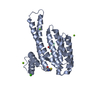 6y3mC  6y3oC  6y3rC  6y3sC  6y3vC  6y40C 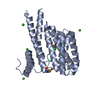 6y44C  6y8aC 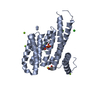 6y8dC 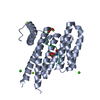 6y8eC 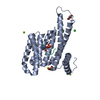 3lw1S S: Starting model for refinement C: citing same article ( |
|---|---|
| Similar structure data |
- Links
Links
- Assembly
Assembly
| Deposited unit | 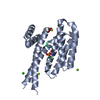
| ||||||||||||
|---|---|---|---|---|---|---|---|---|---|---|---|---|---|
| 1 | 
| ||||||||||||
| Unit cell |
| ||||||||||||
| Components on special symmetry positions |
|
- Components
Components
| #1: Protein | Mass: 28226.518 Da / Num. of mol.: 1 Source method: isolated from a genetically manipulated source Source: (gene. exp.)  Homo sapiens (human) / Gene: SFN, HME1 / Production host: Homo sapiens (human) / Gene: SFN, HME1 / Production host:  | ||||||||
|---|---|---|---|---|---|---|---|---|---|
| #2: Protein/peptide | Mass: 1031.052 Da / Num. of mol.: 1 / Source method: obtained synthetically / Source: (synth.)  Homo sapiens (human) / References: UniProt: P42575*PLUS Homo sapiens (human) / References: UniProt: P42575*PLUS | ||||||||
| #3: Chemical | | #4: Chemical | ChemComp-CL / | #5: Water | ChemComp-HOH / | Has ligand of interest | Y | Has protein modification | Y | |
-Experimental details
-Experiment
| Experiment | Method:  X-RAY DIFFRACTION / Number of used crystals: 1 X-RAY DIFFRACTION / Number of used crystals: 1 |
|---|
- Sample preparation
Sample preparation
| Crystal | Density Matthews: 2.5 Å3/Da / Density % sol: 50.71 % |
|---|---|
| Crystal grow | Temperature: 277 K / Method: vapor diffusion, sitting drop Details: 28% PEG400, 5% glycerol, 0.2M CaCl, 0.1M HEPES pH 7.5, 2mM BME |
-Data collection
| Diffraction | Mean temperature: 100 K / Serial crystal experiment: N |
|---|---|
| Diffraction source | Source:  SYNCHROTRON / Site: SYNCHROTRON / Site:  Diamond Diamond  / Beamline: I03 / Wavelength: 0.973 Å / Beamline: I03 / Wavelength: 0.973 Å |
| Detector | Type: DECTRIS EIGER2 XE 16M / Detector: PIXEL / Date: Feb 28, 2020 |
| Radiation | Protocol: SINGLE WAVELENGTH / Monochromatic (M) / Laue (L): M / Scattering type: x-ray |
| Radiation wavelength | Wavelength: 0.973 Å / Relative weight: 1 |
| Reflection | Resolution: 1.54→30.05 Å / Num. obs: 42300 / % possible obs: 97.6 % / Redundancy: 10.3 % / Biso Wilson estimate: 16 Å2 / CC1/2: 0.996 / Net I/σ(I): 14.3 |
| Reflection shell | Resolution: 1.54→1.57 Å / Num. unique obs: 1084 / CC1/2: 0.66 |
- Processing
Processing
| Software |
| ||||||||||||||||||||||||||||||||||||||||||||||||||||||||||||||||||||||||||||||||||||||||||||||||||||||||||||||||
|---|---|---|---|---|---|---|---|---|---|---|---|---|---|---|---|---|---|---|---|---|---|---|---|---|---|---|---|---|---|---|---|---|---|---|---|---|---|---|---|---|---|---|---|---|---|---|---|---|---|---|---|---|---|---|---|---|---|---|---|---|---|---|---|---|---|---|---|---|---|---|---|---|---|---|---|---|---|---|---|---|---|---|---|---|---|---|---|---|---|---|---|---|---|---|---|---|---|---|---|---|---|---|---|---|---|---|---|---|---|---|---|---|---|
| Refinement | Method to determine structure:  MOLECULAR REPLACEMENT MOLECULAR REPLACEMENTStarting model: 3LW1 Resolution: 1.54→30.05 Å / SU ML: 0.1642 / Cross valid method: FREE R-VALUE / σ(F): 1.34 / Phase error: 21.5285
| ||||||||||||||||||||||||||||||||||||||||||||||||||||||||||||||||||||||||||||||||||||||||||||||||||||||||||||||||
| Solvent computation | Shrinkage radii: 0.9 Å / VDW probe radii: 1.11 Å | ||||||||||||||||||||||||||||||||||||||||||||||||||||||||||||||||||||||||||||||||||||||||||||||||||||||||||||||||
| Displacement parameters | Biso mean: 20.87 Å2 | ||||||||||||||||||||||||||||||||||||||||||||||||||||||||||||||||||||||||||||||||||||||||||||||||||||||||||||||||
| Refinement step | Cycle: LAST / Resolution: 1.54→30.05 Å
| ||||||||||||||||||||||||||||||||||||||||||||||||||||||||||||||||||||||||||||||||||||||||||||||||||||||||||||||||
| Refine LS restraints |
| ||||||||||||||||||||||||||||||||||||||||||||||||||||||||||||||||||||||||||||||||||||||||||||||||||||||||||||||||
| LS refinement shell |
|
 Movie
Movie Controller
Controller


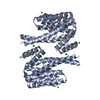
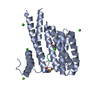
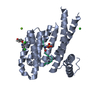

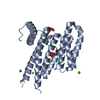
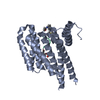
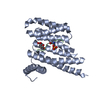
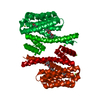


 PDBj
PDBj



















